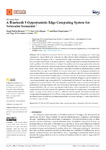A Bluetooth 5 Opportunistic Edge Computing System for Vehicular Scenarios

Use este enlace para citar
http://hdl.handle.net/2183/32755Colecciones
- Investigación (FIC) [1678]
Metadatos
Mostrar el registro completo del ítemTítulo
A Bluetooth 5 Opportunistic Edge Computing System for Vehicular ScenariosFecha
2022-11-01Cita bibliográfica
Niebla-Montero, Á.; Froiz-Míguez, I.; Fraga-Lamas, P.; Fernández-Caramés, T.M. A Bluetooth 5 Opportunistic Edge Computing System for Vehicular Scenarios. Eng. Proc. 2022, 27, 66. https://doi.org/10.3390/ecsa-9-13214
Resumen
[Abstract]: The limitations of many IoT devices in terms of storage, computing power and energy consumption require them to be connected to other devices when performing computationally intensive tasks, as happens with IoT systems based on edge computing architectures. However, the lack of wireless connectivity in the places where IoT nodes are deployed or through which they move is still a problem. One of the solutions to mitigate this problem involves using opportunistic networks, which provide connectivity and processing resources efficiently while reducing the communications traffic with remote clouds. Thus, opportunistic networks are helpful in situations when wireless communication coverage is not available, as occurs in certain rural areas, during natural disasters, in wars or when other factors cause network disruptions, as well as in other IoT scenarios in which the cloud becomes saturated (for example, due to an excessive amount of concurrent communications or when denial-of-service (DoS) attacks occur). This article presents the design and initial validation of a novel opportunistic edge computing (OEC) system based on Bluetooth 5 and the use of low-cost single-board computers (SBCs). After describing the proposed OEC system, experimental results are presented for a real opportunistic vehicular IoT scenario. Specifically, the latency and packet loss are measured thanks to the use of an experimental testbed made of two separate IoT networks (each conformed by an IoT node and an OEC gateway): one located in a remote office and another one inside a moving vehicle, which was driven at different vehicular speeds. The obtained results show average latencies ranging from 716 to 955 ms with packet losses between 7% and 27%. As a result, the developed system is useful for providing opportunistic services to moving IoT nodes with relatively low latency requirements.
Palabras clave
Bluetooth 5
Edge computing
IoT
Opportunistic edge computing
Vehicular scenarios
Edge computing
IoT
Opportunistic edge computing
Vehicular scenarios
Versión del editor
Derechos
Atribución 3.0 España
ISSN
2673-4591






